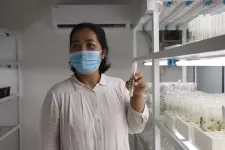(Press-News.org) Embargoed for release until 5:00 p.m. ET on Monday 5 February 2024
Annals of Internal Medicine Tip Sheet
@Annalsofim
Below please find summaries of new articles that will be published in the next issue of Annals of Internal Medicine. The summaries are not intended to substitute for the full articles as a source of information. This information is under strict embargo and by taking it into possession, media representatives are committing to the terms of the embargo not only on their own behalf, but also on behalf of the organization they represent.
----------------------------
1. Persons diagnosed with PCOS face 8-fold increase in suicide risk
Abstract: https://www.acpjournals.org/doi/10.7326/M23-2240
URL goes live when the embargo lifts
A study of more than 18,000 women found that patients diagnosed with polycystic ovary syndrome (PCOS) were 8 times more likely to attempt suicide compared with control group. These findings highlight the importance of routine monitoring of mental health and suicide risk in persons diagnosed with PCOS. The study is published in Annals of Internal Medicine.
PCOS is a prevalent endocrine disorder, affecting up 10% of women in their reproductive years. Common attributes associated with PCOS include infertility, acne, dysmenorrhea, hirsutism, and obesity, which can collectively contribute to a decreased quality of life. In addition, a substantial body of evidence indicates that persons diagnosed with PCOS have higher risk for psychiatric conditions, such as depressive disorders, anxiety disorders, personality disorder, and schizoaffective disorder.
Researchers from Taipei Veterans General Hospital studied data from the Taiwanese nationwide database from 1997 to 2012 for 18,960 women diagnosed with PCOS to assess suicide risk, accounting for psychiatric comorbid conditions and age group. They found that persons diagnosed with PCOS faced an 8.47-fold increase in risk for suicide attempt compared with the control group, even after accounting for demographics, psychiatric comorbid conditions, physical conditions, and all-cause clinical visits. An adolescent subgroup had a notable 5.38-fold elevated risk for suicide attempt. The authors note that their findings remained robust when excluding the first year or the first 3 years of observation.
Media contacts: For an embargoed PDF, please contact Angela Collom at acollom@acponline.org. To speak with the corresponding authors, Mu-Hong Chen, MD, PhD or Chih-Sung Liang, MD, please contact lcsyfw@gmail.com.
----------------------------
2. Recommending universal breast cancer screening at 40 risks confusion and harms women and USPSTF
Abstract: https://www.acpjournals.org/doi/10.7326/M23-2908
URL goes live when the embargo lifts
A draft of an updated United States Preventive Services Task Force (USPSTF) breast cancer screening guideline recommends screening for all women at average risk starting at age 40. In an Annals of Internal Medicine commentary, Dr. Russell Harris, a former member of the USPSTF, says that many may not understand that this is a departure from previous USPSTF breast cancer screening recommendations even though no new high-quality evidence has emerged.
The commentary summarizes the development of evidence and USPSTF recommendations over the past 25 plus years. Previous USPSTF recommendations were to start universal screening at age 50 and to assist women in their 40s make individual decisions about when to begin screening. There is always a chance of being harmed with screening. The rationale for this previous recommendation was that the potential benefit of starting screening at 40 is small, whereas the potential benefit is larger for women starting screening at age 50. Thus, the thinking was that women in their 40s should make an individual, informed choice about screening based on each woman’s preferences and values.
The harms of screening include not only false alarms, with additional procedures and anxiety, but also finding a slow-growing “cancer” that would never progress to threaten the woman’s life. This “overdiagnosis” leads then to unnecessary treatment and further life changing consequences.
Dr. Harris believes that recommending universal screening for average risk women in their 40s, with its attendant harms, is a departure from the USPSTF’s evidence-based approach. He hopes that the commentary will help reduce confusion for clinicians and patients.
Media contacts: For an embargoed PDF, please contact Angela Collom at acollom@acponline.org. To speak with the corresponding author Russell P. Harris, MD, MPH, please contact russell_harris@med.unc.edu.
----------------------------
3. Adults in serious psychological distress faced decreased access to outpatient mental health care during COVID-19 pandemic
Abstract: https://www.acpjournals.org/doi/10.7326/M23-2824
URL goes live when the embargo lifts
A national survey found that the rate of serious psychological distress among adults increased between 2018 and 2021, but their access to outpatient mental health care decreased during the same period. These trends and patterns underscore the persistent challenges of connecting older adults, unemployed persons, and seriously distressed adults to outpatient mental health care. The study is published in Annals of Internal Medicine.
In addition to the physical disease burden of the COVID-19 pandemic, concern exists over its adverse mental health effects. Several factors, including fear and grief, COVID-19–related morbidity, social restrictions and isolation, financial uncertainty, and work and school disruptions, may have contributed to increasing psychological distress. While increased use of telemedicine may have boosted mental health care during the acute phase of the COVID-19 pandemic, there are new concerns that some patient groups have difficulty accessing these services, compounding existing disparities in outpatient mental health care.
Researchers from Columbia University and New York State Psychiatric Institute analyzed data for 86,658 adults from the 2018–2021 Medical Expenditure Panel Surveys (MEPS) conducted by the Agency for Healthcare Research and Quality to characterize trends in psychological distress and outpatient mental health care and to describe patterns of in-person, telephone, and video outpatient mental health care.
Responses indicated that the rate of serious psychological distress among adults increased from 3.5 to 4.2 percent during the study period. During the same period, the rate of outpatient mental health care increased from 11.2 to 12.4 percent overall. Despite this increase, the rate of care among adults with serious psychological distress decreased from 46.5 to 40.4 percent.
A significant increase in outpatient mental health care was observed for young adults and employed adults, but not among middle-aged, older, or unemployed adults, suggesting that for these patients, lack of broadband access, lower digital literacy, social isolation, and absence of support networks to assist with technological challenges might pose barriers to telehealth care. The authors suggest interventions to reduce these disparities.
Media contacts: For an embargoed PDF, please contact Angela Collom at acollom@acponline.org. To speak with the corresponding author, Mark Olfson, MD, MPH, please contact Stephanie Berger at sb2247@cumc.columbia.edu.
----------------------------
4. Use of decision support tools reduces low-value care from clinicians seeing older patients
Abstract: https://www.acpjournals.org/doi/10.7326/M23-2183
Editorial: https://www.acpjournals.org/doi/10.7326/M24-3501
URL goes live when the embargo lifts
A study of 371 primary care physicians and older patients at 60 clinics found that the use of point-of-care clinical decision support tools and education reduced instances of low-value care for patients aged 65 years and older. The study is published in Annals of Internal Medicine.
The overuse of low-value, unnecessary care remains a problem in American health care. Professional organizations have launched campaigns to raise awareness of these harms for physicians, but these practices stubbornly persist with variations across regions and health systems.
Researchers from Northwestern University Feinberg School of Medicine conducted an 18-month, single-blind, pragmatic, cluster randomized trial, with constrained randomization to evaluate the effects of a clinician decision support tool on care overuse among older patients. The trial included 371 primary care clinicians and their older adult patients from 60 primary care internal medicine, family medicine and geriatrics practices from September 2020 through February 2022. The authors delivered behavioral science–informed, point-of-care, clinical decision support tools plus brief case-based education addressing three categories of unnecessary testing in older adults: Prostate-specific antigen (PSA) testing in men aged 76 years and older without previous prostate cancer, urine testing for nonspecific reasons in women aged 65 years and older, and overtreatment of diabetes with hypoglycemic agents in patients aged 75 years and older and hemoglobin A1c (HbA1c) less than 7%. They found that the use of clinical decision support tools and education reduced all three categories of unnecessary testing more than interventions only focusing on education. According to the authors, these findings suggest that point-of-care behaviorally informed interventions can reduce overuse among older patients of primary care clinicians while preserving clinician discretion.
The author of an accompanying editorial from Johns Hopkins University discusses how various scientists, including behavioral, economists, and organizational theorists approach the complex problem of health care overuse. The author says that in their practice, the scientists at Johns Hopkins have been operationalizing points of intervention to reduce overuse using an agentic-structural framework considering both micro- and macro-level interventions that require different levels of work on the part of all affected by the issue. They look forward to additional randomized trials that test solutions to reducing low-value care.
Media contacts: For an embargoed PDF, please contact Angela Collom at acollom@acponline.org. To speak with the corresponding author, Stephen D. Persell, MD, MPH, please contact Marla Paul at marla-paul@northwestern.edu.
----------------------------
END
Persons diagnosed with PCOS face 8-fold increase in suicide risk
2024-02-05
ELSE PRESS RELEASES FROM THIS DATE:
Mental health care during the COVID-19 era remains inaccessible to many distressed US adults
2024-02-05
U.S. adults experienced considerable psychological distress and adverse mental health effects as a result of the COVID-19 pandemic according to a study at Columbia University Mailman School of Public Health and Columbia University Irving Medical Center. Based on insurance claims, mental health care provider surveys, and electronic health records the research further revealed a decline in in-person outpatient mental health visits during the acute phase of the pandemic. Findings are reported ...
Magnesium protects tantalum, a promising material for making qubits
2024-02-05
UPTON, NY—Scientists at the U.S. Department of Energy’s (DOE) Brookhaven National Laboratory have discovered that adding a layer of magnesium improves the properties of tantalum, a superconducting material that shows great promise for building qubits, the basis of quantum computers. As described in a paper just published in the journal Advanced Materials, a thin layer of magnesium keeps tantalum from oxidizing, improves its purity, and raises the temperature at which it operates as a superconductor. All three may increase tantalum’s ability ...
From Colombia to Laos: protecting crops through nanotechnology
2024-02-05
In a recent breakthrough, DNA sequencing technology has uncovered the culprit behind cassava witches’ broom disease: the fungus genus Ceratobasidium.
The cutting-edge nanopore technology used for this discovery was first developed to track the COVID-19 virus in Colombia, but is equally suited to identifying and reducing the spread of plant viruses. The findings, published in Scientific Reports, will help plant pathologists in Laos, Cambodia, Vietnam and Thailand protect farmers’ valued cassava harvest.
“In Southeast ...
New guideline details acute pain management strategies for adolescent, adult dental patients
2024-02-05
CHICAGO, Feb. 5, 2024 – Nonsteroidal anti-inflammatory drugs (NSAIDs) taken alone or along with acetaminophen are recommended as first-line treatments for managing short-term dental pain in adults and adolescents aged 12 or older, according to a new clinical practice guideline developed by the American Dental Association (ADA), the University of Pittsburgh School of Dental Medicine and the Center for Integrative Global Oral Health at the University of Pennsylvania School of Dental Medicine. The guideline has been endorsed by the ADA and is now available in the February issue of The Journal ...
How ‘deaths of despair’ differ by race and ethnicity
2024-02-05
COLUMBUS, Ohio – White Americans are more likely than Black and Hispanic people in the United States to experience “deaths of despair” even though they are less likely to suffer from severe psychological distress, a new study finds.
The results suggest that, for some reason, whites are more vulnerable to the damaging effects of psychological distress than Blacks or Hispanics, said Hui Zheng, lead author of the study and professor of sociology at The Ohio State University. Zheng is currently on leave at the University of Hong Kong.
“The white population has an increasing trend of despair-related mortality after 2000,” Zheng said. ...
Understanding how soil traps carbon
2024-02-05
EVANSTON, Ill. — When carbon molecules from plants enter the soil, they hit a definitive fork in the road.
Either the carbon gets trapped in the soil for days or even years, where it is effectively sequestered from immediately entering the atmosphere. Or it feeds microbes, which then respire carbon dioxide (CO2) into the ever-warming environment.
In a new study, Northwestern University researchers determined the factors that could tip plant-based organic matter in one direction or the other.
By combining laboratory experiments and molecular modeling, researchers ...
USC researchers uncover biological circuit that protects plants from extreme conditions
2024-02-05
Climate change is already harming agricultural yields and may one day pose a significant threat to the world’s food supply. Engineering more resilient crops, including those able to thrive in the face of drought or high soil salinity levels, is an increasingly urgent need.
A new study from the Keck School of Medicine of USC, funded in part by the National Institutes of Health, reveals details about how plants regulate their responses to stress that may prove crucial to those efforts. Researchers found that plants use their circadian clocks to respond to changes in external water and salt levels throughout the day. That same circuitry—an ...
Study reveals significant discrepancies in common poverty measurement approaches
2024-02-05
Methods commonly used to measure poverty can lead to vastly different conclusions about who actually lives in poverty, according to a new Stanford University-led study. Based on household surveys in sub-Saharan Africa, the first-of-its-kind analysis, published Feb. 5 in Proceedings of the National Academy of Sciences, underscores the importance of accurately defining and measuring poverty. Its findings could help inform how governments, nonprofit organizations, and international development agencies allocate resources and evaluate the effectiveness of poverty-alleviation policies around the world.
“They say you can’t manage what ...
Mystery of moths’ warning sound production explained in new study
2024-02-05
The workings of the ultrasonic warning sounds produced by the wings of a species of moth have been revealed by researchers at the University of Bristol.
Scientists recently discovered that moths of the genus Yponomeuta (so-called ermine moths) have evolved a very special acoustic defence mechanism against their echolocating predators—bats.
Ermine moths produce ultrasonic clicking sounds twice per wingbeat cycle using a minute corrugated membrane in their hindwing. Strikingly, these moths lack hearing organs and are therefore not aware of their unique defence mechanism, nor do they have the capability to control it using muscular ...
MIT researchers map the energy transition’s effects on jobs
2024-02-05
A new analysis by MIT researchers shows the places in the U.S. where jobs are most linked to fossil fuels. The research could help policymakers better identify and support areas affected over time by a switch to renewable energy.
While many of the places most potentially affected have intensive drilling and mining operations, the study also measures how areas reliant on other industries, such as heavy manufacturing, could experience changes. The research examines the entire U.S. on a county-by-county level.
“Our result ...




